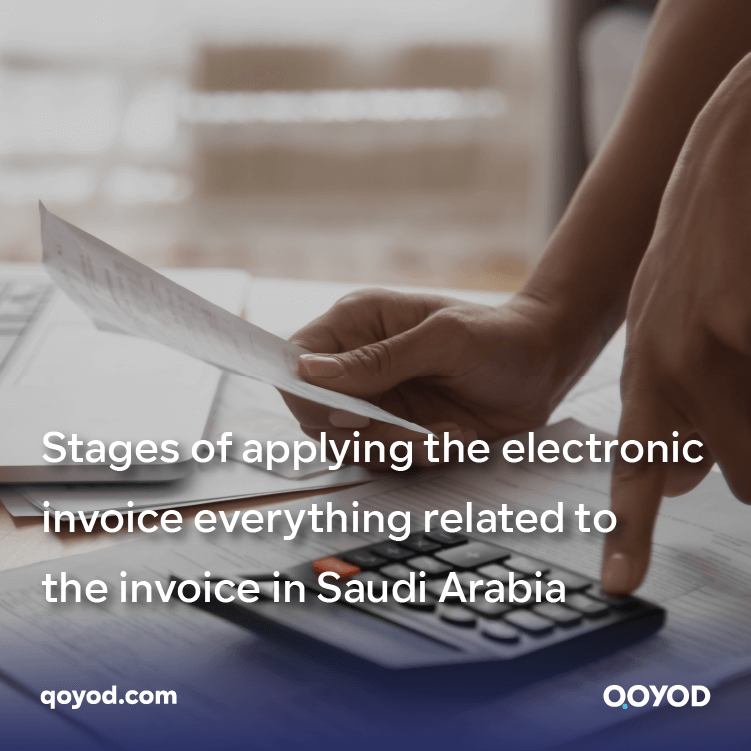The crowded office noise, the carefully wrapped bill sheet in your hand, and the burden of manual input… These are scenes that we’re used to in the business world, but can you imagine a world where chaos is becoming smooth and paper is becoming sophisticated digital data? Let us dive into the world of the future with a new business revolution: the electronic bill revolution. The stages of the application of the electronic bill consist of the conversion of financial and commercial data into an electronic form that is easily traded and stored. The journey begins with the creation of the electronic bill, the addition of the necessary details, and then goes to the recipient via e-mail or short message system. The invoice is finally entered into the central database of the government or the competent authority.
Stages of applying the electronic invoice in Saudi Arabia
The stages of applying electronic invoicing usually take place in two stages, which can be summarized as follows:
First stage
It is the issuance and archiving phase that began on December 4, 2021. At this stage, electronic invoicing is applied to all persons subject to the e-invoice regulation, including those who act on behalf of those charged with issuing invoices.
Electronic invoices at this stage are issued in the same way as traditional invoices, but through the use of a compatible electronic billing system, and must include all the required elements according to the specific invoice type.
Second stage
The second stage started on January 1, 2023, in a phased manner, and at this stage, the electronic solution integrates with the system of the Zakat, Tax, and Customs Authority and must be issued in the required format according to the specified requirements.
Electronic invoices must be compatible with the approved system and contain all the necessary information required to meet the needs of the Zakat, Tax, and Customs Authority.
Note
Electronic invoicing moves through these stages with the aim of improving the efficiency and accuracy of the invoicing process, facilitating verification and auditing processes, improving communication between stakeholders, reducing paper use, achieving cost savings, and reducing the efforts associated with the traditional invoicing process.
What is the Saudi billing system?
After we know what the stages of applying the electronic invoice are, we should know what the electronic invoice system? is.It is a system that aims to transform the process of issuing paper invoices and notices into an easy and organized electronic process. This system allows the exchange of invoices, debits, and credit notes between the seller and the buyer electronically and securely, using an integrated electronic format.
The importance of the electronic invoice
The transition to electronic invoicing is an important development in business and financial operations. Here, I will review some of the main points that highlight the importance of this transformation:
Enhance transparency and meet compliance requirements.
The e-invoice provides accurate and transparent tracking of billing processes, as every step and movement in the supply chain can be recorded electronically, allowing companies and regulators to achieve local and international compliance requirements more easily.
Reduce the frequency of tax audits.
Compared to paper invoices, the use of electronic invoice application stages can facilitate tax audits and reduce the effort expended in them, as tax authorities can access the necessary data easily and quickly, reducing the total time and effort required to conduct an audit.
Increase efficiency and accuracy in invoice creation.
Electronic invoicing enables the use of predefined templates and integration with inventory management and sales systems, reducing human error and increasing the accuracy and speed of invoice creation.
Create a shared database for audits.
Electronic invoicing can contribute to the creation of a common database that can be accessed by businesses, suppliers, customers, and regulators, thus facilitating audits and increasing transparency and trust between stakeholders.
Reduce costs
Electronic invoicing can reduce the costs associated with printing, distribution, and storage of invoices, in addition to the costs of managing papers, the space required to store them, and the costs of auditing and internationalization.
Improved cash flow
Electronic invoicing can speed up payment processes and improve the cash flow of companies, as electronic invoices can be submitted in real time, monitor payment status, and collect funds faster, which contributes to improving the company’s overall cash flow.
Improve the data management process.
With the phases of e-invoice implementation, data can be stored and managed more effectively and easily, as invoices and related data can be accessed quickly and accurately, helping to improve decision-making processes and business management.
Eliminate fraudulent activities.
Electronic invoicing provides an additional layer of security and credibility, as encryption and digital signature techniques can be adopted to ensure the authenticity of invoices, thus reducing the chances of forgery and fraudulent activities.
How to approve the electronic invoice in your facility
After we have learned the stages of applying the electronic invoice, you should know that approving it in your facility requires specific steps to ensure its successful implementation, and the following is a step-by-step guide that you can follow:
Research and compare different solutions.
Do thorough research on available e-invoicing solutions, compare features and costs, and ensure alignment with your facility’s needs.
Choose a secure solution.
After you know the stages of applying the electronic invoice, make sure that any accounting software you choose provides a high level of security and data protection. Check for data encryption, access protection mechanisms, and authentication.
Consider scalability
Choose a solution that allows you to expand capabilities in the future, and it’s worth noting that you may need to add more users or expand your business, so make sure the solution supports this scalability.
Integrate your billing system with your existing systems.
Check that your e-invoice system is compatible with your existing systems, such as a securities management system or accounting system, and remember that the system should be able to seamlessly exchange data with these systems.
Review your workflows.
Review and analyze your existing workflows to understand how e-invoicing is integrated into them, and then identify processes that need to be modified or restructured to fit e-invoicing.
Collaborate with your IT team.
Collaborate with your organization’s IT team to implement and support the e-invoicing system, as they can help you choose the right solution and ensure that it is effectively integrated with your existing IT architecture.
Make sure the data is compatible.
Before implementing electronic invoicing, make sure that the required data on invoices complies with local tax laws and requirements. Verify that the new system can include all the necessary data on invoices.
Test your chosen system.
Perform the new system after its implementation to ensure that it works properly according to your needs, and do not forget to conduct tests, review the billing process, and verify the correctness and completeness of the generated data.
Training staff on the new process
Provide employees with comprehensive training on how to use the new e-invoicing system, which may include clarification of procedures, new features, and instructions for invoicing.
Performance monitoring and evaluation
Monitor the performance of the new system, evaluate its effectiveness over a certain period of time, and also collect feedback from employees and customers, use it to improve the process, and modify the system if necessary.
Note
If you are looking for an integrated accounting program that guarantees you all this and more, Qoyod certainly appears to you at the top of the list, as it ensures that you know the stages of applying the electronic invoice and do traditional operations instead of you, allowing you to devote yourself to what is most important.
Conclusion
When we take a look at the stages of applying the electronic invoice, we find that it represents more than just adopting new technology in business operations, it is a transformative journey that takes us to a world of continuous development and improvement, and opens the doors of creativity and influence in the business world, with the application of this type of invoices, many advantages are achieved, Such as: reducing human errors, saving time and effort, improving the speed of trading trading, enhancing transparency and security, in addition to being a modern way of financial and commercial dealings that combines technology and creativity, and contributes to building a more effective and smooth future, so do not let inertia hold you in the past, and do not hesitate to move to the electronic invoice and explore what new advantages it can hold for you.
Join the digital transformation race and prepare for continuous improvement and innovation in your business with the Qoyod program. It is worth noting that the program offers all its customers: electronic invoice systems as well as POS systems, stores, customers, etc.And so on and so forth.
After knowing what the stages of applying the e-invoice are, try Qoyod now for free for 14 days, and let creativity and influence illuminate your path and guide you towards sustainable success and continuous development.




